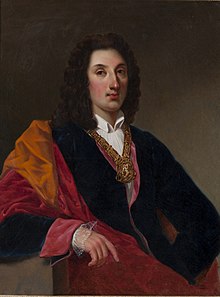Louis Thomas, Count of Soissons
| Louis Thomas | |||||
|---|---|---|---|---|---|
| Count of Soissons | |||||
 Louis Thomas, Count of Soissons. | |||||
| Born | 15 December 1657 Paris, France | ||||
| Died | 14 August 1702 (aged 44) Near Landau | ||||
| Spouse | Uranie de La Cropte de Beauvais | ||||
| Issue Detail | Maria Anna Victoria, Duchess in Saxony Emmanuel Thomas, Count of Soissons | ||||
| |||||
| House | Savoy-Carignano | ||||
| Father | Eugene Maurice, Count of Soissons | ||||
| Mother | Olympia Mancini | ||||
Prince Louis Thomas of Savoy (German: Ludwig Thomas von Savoyen, Graf von Soissons; Italian: Luigi Tommaso di Savoia; 15 December 1657 – 14 August 1702) was a Count of Soissons and Prince of Savoy. He was killed as Feldzeugmeister of the Imperial Army at the Siege of Landau at the start of the War of the Spanish Succession.
Biography
Louis Thomas was the eldest son of Eugene Maurice, Count of Soissons and Olympia Mancini, as well as the oldest brother of Prince Eugene of Savoy. He married Uranie de La Cropte de Beauvais, whom Saint-Simon had once described as "radiant as the glorious morn". His daughter Princess Maria Anna Victoria of Savoy eventually inherited Eugene's estate.[1] His maternal cousins included the Duke of Vendôme as well as the Duke of Bouillon and Louis Henri de La Tour d'Auvergne. His paternal cousins included Victor Amadeus I, Prince of Carignano, Louis William, Margrave of Baden-Baden, son of his aunt Louise of Savoy, and Maximilian II Emanuel, Elector of Bavaria, son of another Savoy Princess and thus just a third cousin of his.
After the premature death of his father in 1673 and the flight of his mother to Brussels due to her involvement in the notorious Poison affair, Louis Thomas and his siblings remained in Paris and were entrusted to the care of their grim grandmother Marie de Bourbon and their aunt Princess Louise of Savoy, Margravine of Baden Baden. Since the family had fallen out of favour with the king because of Olympia Mancini's behaviour, Louis-Thomas inherited the titles of his fathers, but not his offices and thus his income. His sisters and his daughters remained unmarried, his brothers Louis-Jules (1660–1683) and Emanuel-Philibert (1662-1676), and his son Thomas Emmanuel, pursued their military careers outside France, as did his other two brothers that had initially been directed to ecclesiastical careers, Philip (1659–1693), who died fighting for the Venetians against the Turks, and Prince Eugene of Savoy, who became one of the most famous generals in the service of the House of Habsburg.[2][3]
Louis Thomas obtained a commission as an officer in the French Army, but Louis XIV had amorous designs on his wife. Urania, however, spurned the king's romantic advances. Angered, Louis dismissed Louis Thomas from the army, and, when Louis Thomas sought a position abroad, terminated his pension and dues.[citation needed] In 1699, all but bankrupt, Louis Thomas sought the aid of Prince Eugene, in Vienna. With Eugene's help, he obtained a commission in the Austrian Imperial Army.[4][5]
On 18 August Louis was killed by a French bomb at the Siege of Landau at the onset of the War of the Spanish Succession.[6]
Issue
- Princess Maria Anna Victoria of Savoy (1683–1763), Mademoiselle de Soissons; married Prince Joseph of Saxe-Hildburghausen, Duke in Saxony, son of Ernest, Duke of Saxe-Hildburghausen; had no issue.
- Prince Louis Thomas of Savoy (15 December 1685 – 28 September 1695) died aged 10.
- Princess Thérèse Anne Louise of Savoy (15 September 1686– 22 January 1736); never married and had no issue.
- Prince Emmanuel Thomas of Savoy (1687–1729); succeeded as Count of Soissons. He married Princess Maria Theresia of Liechtenstein and had issue.
- Prince Maurice of Savoy (10 January 1690 – 18 September 1710) never married or had issue.
- Prince Eugene of Savoy (23 September 1692 – 23 November 1712) died young without issue.
Ancestry
| Ancestors of Louis Thomas, Count of Soissons | |||||||||||||||||||||||||||||||||||||||||||||||||||||||||||||||||||||||||||||||||||||||||||||||||||||||||||||||||||||||||||||||||||||||||||||||||||||||||||||||||||||||||||||||||||||||||||||||||||||||||||||||||||||||||||||||||||||||||||||||||||||||||||||||||||||||||||||||||||||||||
|---|---|---|---|---|---|---|---|---|---|---|---|---|---|---|---|---|---|---|---|---|---|---|---|---|---|---|---|---|---|---|---|---|---|---|---|---|---|---|---|---|---|---|---|---|---|---|---|---|---|---|---|---|---|---|---|---|---|---|---|---|---|---|---|---|---|---|---|---|---|---|---|---|---|---|---|---|---|---|---|---|---|---|---|---|---|---|---|---|---|---|---|---|---|---|---|---|---|---|---|---|---|---|---|---|---|---|---|---|---|---|---|---|---|---|---|---|---|---|---|---|---|---|---|---|---|---|---|---|---|---|---|---|---|---|---|---|---|---|---|---|---|---|---|---|---|---|---|---|---|---|---|---|---|---|---|---|---|---|---|---|---|---|---|---|---|---|---|---|---|---|---|---|---|---|---|---|---|---|---|---|---|---|---|---|---|---|---|---|---|---|---|---|---|---|---|---|---|---|---|---|---|---|---|---|---|---|---|---|---|---|---|---|---|---|---|---|---|---|---|---|---|---|---|---|---|---|---|---|---|---|---|---|---|---|---|---|---|---|---|---|---|---|---|---|---|---|---|---|---|---|---|---|---|---|---|---|---|---|---|---|---|---|---|---|---|---|---|---|---|---|---|---|---|---|---|---|---|---|---|---|---|
| |||||||||||||||||||||||||||||||||||||||||||||||||||||||||||||||||||||||||||||||||||||||||||||||||||||||||||||||||||||||||||||||||||||||||||||||||||||||||||||||||||||||||||||||||||||||||||||||||||||||||||||||||||||||||||||||||||||||||||||||||||||||||||||||||||||||||||||||||||||||||
References
- ^ Henderson, N. (1964). Prince Eugen of Savoy, a Biography. Weidenfeld and Nicolson. p. 290. ISBN 978-1-84212-597-7.
- ^ Arneth, pp. 7 and 136
- ^ Bianchi, DBI.
- ^ Arneth, pp. 125–126.
- ^ Braubach, p. 97.
- ^ Skala, Harald (2005). "Die Belagerung von Landau 1702 und 1703". Archived from the original on 2015-10-07. Retrieved 5 October 2014.
- This article contains material translated from the equivalent article in the German Wikipedia.
Bibliography
- von Arneth, Alfred Ritter (1864). Prinz Eugen von Savoyen. Nach den handschriftlichen Quellen der kaiserlichen Archive (in German). Vol. 1. 1663–1707. Vienna: Braumüller.
- Bianchi, Paola (2018). "SAVOIA SOISSONS, Eugenio Maurizio". Dizionario Biografico degli Italiani (in Italian). Vol. 91. Rome: Istituto dell'Enciclopedia Italiana. Retrieved 11 May 2024.
- Braubach, Max (1950). Geschichte und Abenteuer. Gestalten um den Prinzen Eugen (in German). Munich: Verlag Bruckmann.
